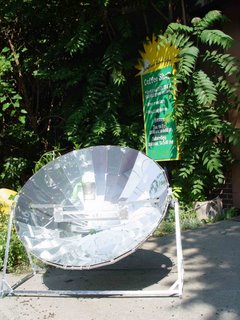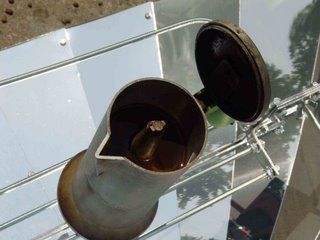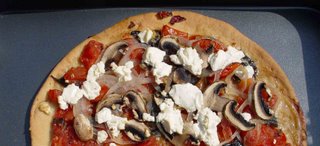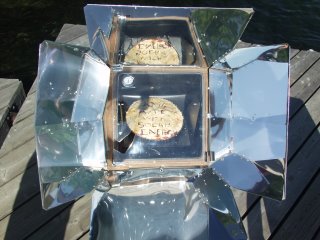Solar breakfast and thoughts on food security
 On Sunday morning I decided to take advantage of some of the only sun we had over the weekend to make my breakfast using solar energy. Once again, I turned to my parabolic solar cooker from Germany, which is the only solar cooker that can fry up bacon and eggs, which were on the menu at my mother's house where I was visiting.
On Sunday morning I decided to take advantage of some of the only sun we had over the weekend to make my breakfast using solar energy. Once again, I turned to my parabolic solar cooker from Germany, which is the only solar cooker that can fry up bacon and eggs, which were on the menu at my mother's house where I was visiting.I had initially planned to cook breakfast for the whole family, mother, father, sister, brother in law, nephew and family friend. The sun came and went, but my family was more interested in eating "on time" using "on demand" fossil energy than in eating renewable energy. So I was able to get away with a single solar meal, for myself. That's the way you use solar energy. Go with the flow. Take it when it appears, just like you'd eat whatever's on the plate your mother serves to you.
We're used to consuming energy "on demand." Want to cook? Turn on the gas. But the world is changing, and we're going to have to get used to capturing "flows" of renewable energy where we can. Up to now, energy demand has governed energy supply. If we wanted more energy, they pumped more oil. Not any more. Peak oil has arrived. North American natural gas production is in permanent decline. Now supply limits demand. In the world of peaking energy and runaway populations (at least for now) all available fossil energy will be consumed, no matter what the price. Somebody will pay for it.
Many geologists and scientists who have investigated these facts and thought deeply about them expect the future of the fossil fuel economy to look something like this:

This future would be one of decreasing per capita energy availability, economic shock, and social upheaval, to say the least. Can we afford NOT to use solar energy wherever we can? I think not.
So how did my breakfast turn out?
Bacon placed in the hot cast iron skillet started to sizzle straight away. Pre-heating took about 10 minutes. So did cooking.
Next, two eggs. Sunny side up. Neither bacon nor eggs stuck to the pan, and both yokes were perfect. Three minutes.
Food Security and Solar Cooking
A decreasing number of my friends think I'm nuts for being so concerned with solar energy, the environment and peak oil and fossil energy. Would that they were right, and there was nothing to worry about. Unfortunately their approach to the questions of sustainability, food security, environmental collapse and peak oil is one of denial. "Things will just keep on going. They always find a new energy source. Peak oil is just a scary conspiracy theory." Would that these were true. The real facts of life would be a lot easier to deal with.
The real facts of life as I see them are these.
Earth's "resources" of land, plant and animal life, water, minerals and fossil fuels are finite.
There are 6.5 billion people and growing, demanding an ever greater share of these finite "resources." (are these things only "resources" for humanity, or do they have an existence outside their "use value" for people? Does that existence impose limits on our behaviour?)
Exponential population growth of any species in nature always leads to a crash and "die-off" once the indispensable resource present in the least amount is consumed. This is Leibig's Law, or the "Law of the Minimum" (for those of you who remember your Dune.) Think algae in a pond once all the dead leaves are consumed.
Global peak oil is happening now. The US military thinks it's already happened. Oil is analogous to the food upon which algae depend.
Runnaway climate change seems to be happening: acid oceans, massive droughts and hurricanes, Europe's bees are dying, I haven't seen a toad in my yard for ten years, melting ice-caps, global ocean conveyor is slowing down, Europe could become like Siberia while the Amazon dries up and burns.
Climate change is directly linked to increased C02 emissions from fossil fuel burning.
Conclusion: we have to do something, whatever we can to reduce our footprint, scale back our use of fossil fuel energy, and get into a harmonious relationship with the cycles of the earth. We all have to eat. Everybody should try to cook with as much renewable energy as they can.
We are living at the peak of human achievement, and at the edge of humanity's hubris. The sane way of living, from my perspective at least, is to take advantage of all that we can accomplish to equip ourselves for "the prosperous way down."
For me, that meant different things than it may have meant to somebody else.
I rent my home right now, so I can't invest in a solar water heater, build a strawbale house, or put a windmill in my backyard. Yet.
I've had the good luck to work in the Canadian solar energy industry for the last several years, but in 2005 we suffered a body blow when the new Canadian federal government under the Tory Stephen Harper decided to suspend funding (recently released) to solar energy projects. A more foolish government could not be imagined. This policy hurt many small solar energy businesses and people who wanted to use solar.
My response was to start my own business selling small scale solar powered products that somebody in my situation could use. I love cooking and really care about where my food comes from, so why shouldn't I care where the energy to cook it comes from? Ten calories of energy from oil and gas are required to produce every single food calorie we consume. That's before cooking.
There are millions of other people like me, who want to use solar energy, but who won't be investing in a PV system any time soon, either because they'll never have the money, or because they'll never have a house to put one on.
I'm turning off my gas stove, and going to spend more time outside in my backyard, making healthy, delicious food. One day in the next couple years I hope to build my own Strawbale house, help create or move into an eco-village. I'm moving towards living sustainably, one step at a time. For now, I'm cooking without carbon.
info@solarcooking.ca
 This past week I put together my new "Long Life Single" solar cooker from Germany. I will be selling these cookers to Canadians who want to cook some of their food without burning scarce and polluting fossil fuels.
This past week I put together my new "Long Life Single" solar cooker from Germany. I will be selling these cookers to Canadians who want to cook some of their food without burning scarce and polluting fossil fuels.








